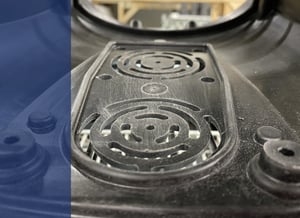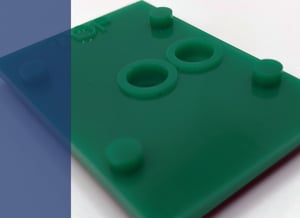RIM vs. Compression Molding: Which Process is Right for Your Product?
Struggling to choose between Reaction Injection Molding (RIM) and Compression Molding for your next project? These two distinct manufacturing processes offer unique benefits that can significantly impact the performance and quality of your product.
Whether you're designing large, intricate parts or highly detailed components, understanding the key differences between RIM and compression molding is crucial. Both methods are versatile solutions for creating products from thermoset materials, but the right choice depends on your specific application needs.

Key Differences at a Glance:
- Reaction Injection Molding (RIM): Ideal for large, complex geometries with varying wall thicknesses
- Compression Molding: Perfect for producing intricate, highly detailed components and small or large parts.
What is Reaction Injection Molding (RIM)?
RIM combines the superior properties of thermoset polyurethanes with the adaptability of injection molding. During the process, thermoset polyurethanes are introduced into a closed, metal mold under high heat and high pressure, allowing for a chemical reaction to occur.
 Why Choose RIM?
Why Choose RIM?
- Ideal for producing large, intricate geometries that may be otherwise difficult to achieve through a cast molding process.
- Produces durable parts such as structural components, enclosures, and housings
- Ideal for applications in medical devices, robotics, and fitness & recreation where performance is critical.
By leveraging the RIM process, manufacturers can create parts with varying wall thicknesses and encapsulated inserts, meeting both structural and aesthetic requirements.
What is Compression Molding?
Compression molding, another common method for processing thermosets like polyurethane, uses high compressive forces to shape materials. In this process, a specific amount of liquid is placed into the center of an open mold cavity, and a second mold compresses the material into shape before it solidifies. While various materials can be used, such as thermoplastics, compression molding with thermosets like polyurethanes provides a good solution to obtain a wide range of shapes, sizes, and forms.

Why Choose Compression Molding?
- Highly customizable and versatile, supporting a wide range of materials and applications
- Can produce complex shapes, fine textures, and small or large parts with ease
- Ideal for components like seals, gaskets, electronic parts, and automotive products
RIM vs. Compression Molding: Which Process Fits Your Needs?
Both RIM and compression molding bring unique strengths to the table. Here's some side by side comparison to help guide your decision:
| Reaction Injection Molding | Compression Molding |
|
|
|
|
|
|
|
|
Which Manufacturing Process is Best for You?
The decision between RIM and compression molding depends on the design, complexity, and performance requirements of your final product.
- Choose RIM for large, structural parts with varying wall thicknesses or if your design calls for encapsulated inserts and complex geometries
- Opt for compression molding if your product requires intricate details, specific physical properties, or if you need to produce a wide range of shapes and sizes.
Ultimately, the best manufacturing method will be the one that meets the specific needs of the product and provides the required quality and performance.
If you're ready to explore how compression molding can enhance your design, complete our design tool here or download our material data sheets below to get started!




